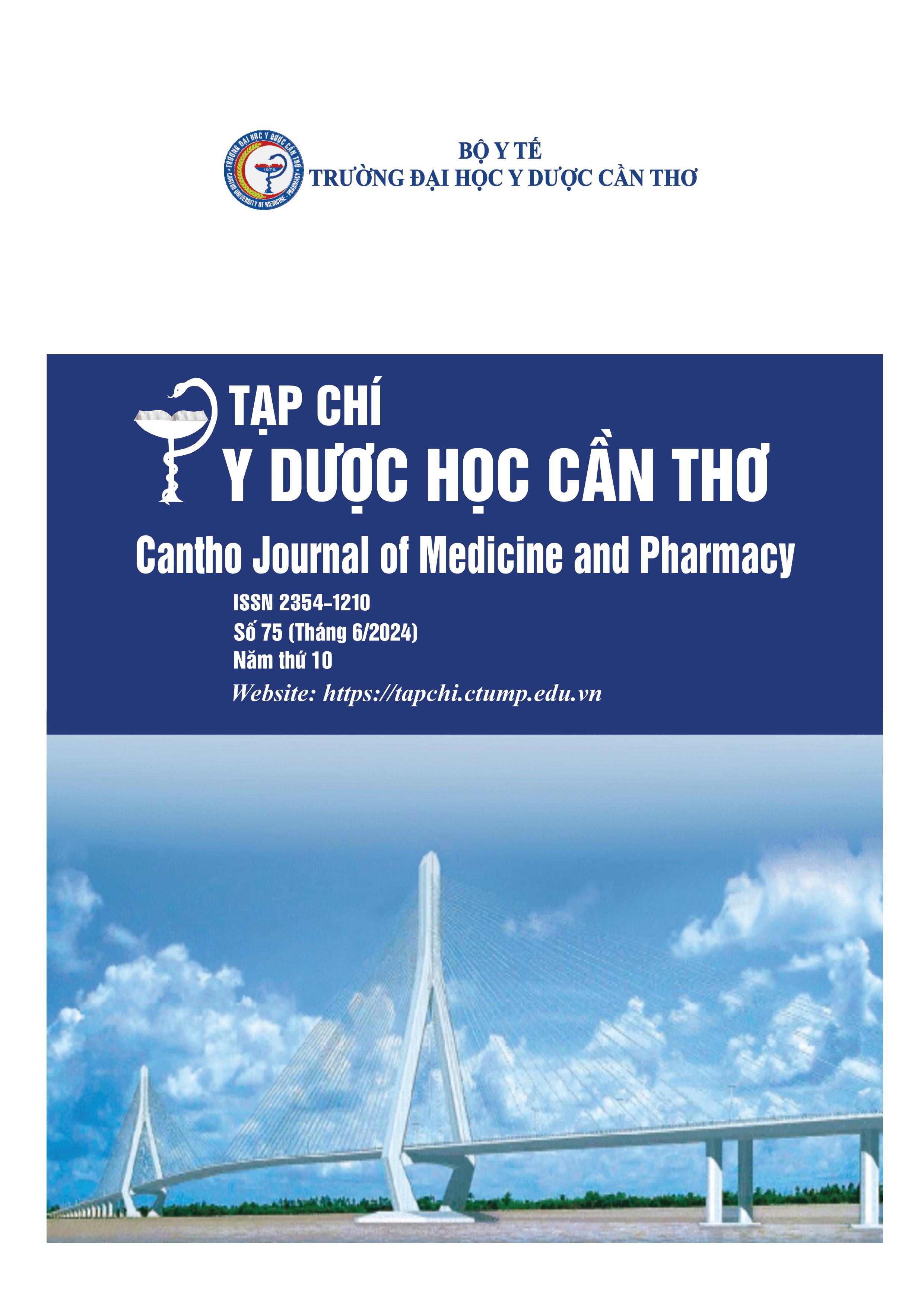EVALUATING THE TREATMENT RESULT ON THE APPLICATION OF HIGH-FLOW NASAL CANNULA IN PATIENTS AFTER EXTUBATION AT CAN THO CENTRAL GENERAL HOSPITAL 2023-2024
Main Article Content
Abstract
Background: Reintubation after extubation is a common problem in artificial ventilation, especially in critically ill patients. Reintubation prolongs ICU treatmentand increases the risk of death. Objectives: To evaluate of treatment results and determining of some factors related to the treatment outcomes on the application of high-flow nasal cannula (HFNC) in patients after extubation at Can Tho Central General Hospital 2023-2024. Materials and methods: A prospective, cross-sectional descriptive study was conducted on 73 patients who were extubated at Can Tho Central General Hospital from March 2023 to April 2024. Results: 76.7% of successful cases switched to nasal oxygen or breathing room air. 23.3% of failed patients required maintenance of high-flow oxygen >48 hours or reintubation. HFNC was effective in improving clinical parameters after 48 hours compared to before the intervention, specifically: heart rate (94.7±15.17 vs 103.88±13.99), respiratory rate (18 ± 4.14 vs 23.59± 3.42), SpO2 (98.8±0.92 vs 96.82± 1.31), mean blood pressure (86.67±8.43 vs. 101.71± 11.95), ROX index (16.5 ± 3.6 vs. 11.71± 2.64) this difference is statistically significant (p<0.05). Conclusions: HFNC effectively reduces the risk of re-intubation and improves clinical outcomes in patients intubated for all causes.
Article Details
Keywords
extubation, high-flow nasal cannula (HFNC), ROX
References
2. Q. Wang, Y. Peng, S. Xu, L. Lin, L. Chen, et al. The efficacy of high-flow nasal cannula (HFNC) versus non-invasive ventilation (NIV) in patients at high risk of extubation failure: a systematic review and meta-analysis. Eur J Med Res. 2023. 28(1), 120, https://doi.org/10.1001/jama.2019.14901.
3. A. W. Thille. G. Muller, A. Gacouin, R. Coudroy, M. Decavèle, et al. Effect of Postextubation
High-Flow Nasal Oxygen With Noninvasive Ventilation vs High-Flow Nasal Oxygen Alone on Reintubation Among Patients at High Risk of Extubation Failure: A Randomized Clinical Trial. Jama. 2019. 322(15), 1465-1475, https://doi.org/10.1001/jama.2019.14901.
4. Bộ Y Tế. Hướng dẫn chẩn đoán và điều trị COVID-19.2021. https://thuvienphapluat.vn/vanban/The-thao-Y-te/Quyet-dinh-2671-QD-BYT-2023-Huong-dan-chan-doan-va-dieu-triCOVID19-570917.aspx
5. Đoàn Lê Minh Hạnh và các cộng sự. Liệu pháp oxy lưu lượng cao qua ống thông mũi (High Flow Nasal Cannula - HFNC). Tạp chí Y Dược học Phạm Ngọc Thạch. 2002.1(2), 30-41, https://doi.org/10.59715/pntjmp.1.2.4
6. G. Hernández C. Vaquero, P. González, C. Subira, F. Frutos-Vivar, et al. Effect of Postextubation High-Flow Nasal Cannula vs Conventional Oxygen Therapy on Reintubation in Low-Risk Patients: A Randomized Clinical Trial. Jama. 2016. 315(13), 1354-61, https://doi.org/10.1001/jama.2016.2711.
7. G. Hernández, I. Paredes, F. Moran, M. Buj, L.Colinas, et al. Effect of postextubation noninvasive ventilation with active humidification vs high-flow nasal cannula on reintubation in patients at very high risk for extubation failure: a randomized trial. Intensive Care Med. 2022. 48(12), 1751-1759, https://doi.org/10.1007/s00134-022-06919-3.
8. Đỗ Ngọc Sơn, Trần Hữu Đạt và Bùi Thị Hương Giang. Giá trị của một số thang điểm dự đoán thành công khi áp dụng kỹ thuật thở oxy làm ẩm dòng cao qua canula mũi sau rút ống nội khí quản ở bệnh nhân đợt cấp bệnh phổi tắc nghẽn mạn tính.Tạp chí Y học Việt Nam. 2023. 531(1B). https://doi.org/10.51298/vmj.v531i1B.7078
9. Trần Thanh Lê, Đỗ Ngọc Sơn và Lương Quốc Chính. Hiệu quả của thở oxy làm ẩm dòng cao qua canuyn mũi trên bệnh nhân đợt cấp bệnh phổi tắc nghẽn mạn tính. Tạp chí Y học Việt Nam. 2022.520(1A). https://doi.org/10.51298/vmj.v520i1.3771.
10. D. Tan, J. H. Walline, B. Ling, Y. Xu, J. Sun, et al. High-flow nasal cannula oxygen therapy versus non-invasive ventilation for chronic obstructive pulmonary disease patients after extubation: a multicenter, randomized controlled trial. Crit Care. 2020. 24(1), 489, https://doi.org/10.1186/s13054-020-03214-9.
11. Y. Ge, Z. Li, A. Xia, J. Liu, D. Zhou. Effect of high-flow nasal cannula versus non-invasive ventilation after extubation on successful extubation in obese patients: a retrospective analysis of the MIMIC-IV database. BMJ Open Respir Res. 2023. 10(1), https://doi.org/10.1136/bmjresp-2023-00173.
12. J. Sun, T. Li, B. Ling, Q. Zhu, Y. Hu, et al. High flow nasal cannula oxygen therapy versus noninvasive ventilation for chronic obstructive pulmonary disease with acute-moderate hypercapnic respiratory failure: an observational cohort study. Int J Chron Obstruct Pulmon Dis. 2019. 14, 1229-1237, https://doi.org/10.2147/copd.S206567.
13. Đào Thị Hương. Nghiên cứu ứng dụng hệ thống thớ oxy lưu lượng cao ở bệnh nhân có nguy cơ phải đặt lại nội khí quản sau rút ống. Trường Đại học Y Hà Nội. 2017, 78.


